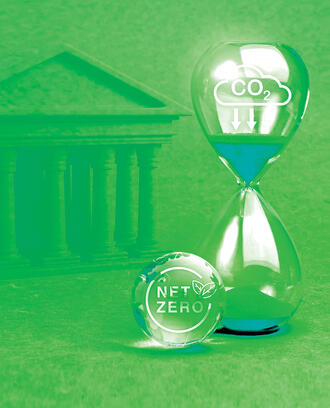Ideas Made to Matter
Sustainability
Game on: How an MIT Sloan grad led the NHL’s first big step to sustainability
The NHL last month named energy company Constellation the official preferred energy provider of the league, a deal that will find Constellation providing energy efficiency analysis for the league and offsetting the carbon footprint of its 2014-2015 season.
The Dec. 18 announcement was a big one for the hockey league, which since 2010 has been touting its NHL Green initiative and which in July released a massive sustainability report chronicling the environmental impact of its games, its arenas, its corporate partners, and even the travel of its fans.
The report is the work of Omar Mitchell, MBA ’12, who joined the NHL in 2012 as director of sustainability. Add in accompanying projects like a push to introduce energy- and heat-saving LED lighting in hockey arenas, and Mitchell has had a busy three years.
The sustainability report—a “tome,” Mitchell only half-jokes—was never a given. Though all of North America’s major sports leagues have some type of sustainability initiative, none has taken on such a hefty task, especially one not required of them. By voluntarily reporting its carbon footprint, the NHL is putting a stake in the ground and publically challenging itself to improve, Mitchell said.
For a sport whose greatest players learned the game on frozen ponds, there is an existential element to the threat of climate change. The report notes that NHL fans are more likely to recycle, support environmental causes, and buy eco-friendly products than the average U.S. adult.
“Moreover, to continue to stage world class outdoor hockey events like the NHL Winter Classic, NHL Heritage Classic, or NHL Stadium Series,” Commissioner Gary Bettman wrote in the report, “we need winter weather.”
A data puzzle
Producing such an extensive report and using it to identify and drive sustainability initiatives required significant buy-in and partnership not only at the league offices in New York City, but among its 30 teams. Mitchell gained that support with the help of only one full-time staffer and an intern. To develop the report, he worked with the National Resources Defense Council, a climate change advocacy group and NHL Green’s primary advisor.
“Working with outside independent groups like the NRDC gave me legitimacy when I went and spoke to my executives internally that this report is something that is going to be solid, validated,” Mitchell said. The partnership also traded on the Natural Resource Defense Council’s “prominence in the environmental space when releasing the report,” he said.
Mitchell began work on the report during an internship at the NHL arranged through the MIT Sloan Sustainability Initiative. He toured the U.S. and Canada, visiting NHL teams at their home arenas, cataloging sustainability practices and initiatives in facility management, corporate partnership, and fan engagement. The report became an exercise in data collection, an opportunity to see what the NHL was doing well, what some teams were excelling in, where others had fallen behind, and what gaps might be filled.
Collecting, tabulating, and arranging data for the report was a massive undertaking. Record keeping and measurements varied from team to team. Complicating matters: no NHL team is the sole tenant of its arena, so determining how much energy use—or savings—should be attributed to NHL events was also a challenge.
“There were certainly opportunities we saw in the data we were collecting,” Mitchell said. “There were opportunities to get better data: electricity metrics, gas metrics, water consumption.”
“We think of the report as ‘This is where we are,’” he said. “And then, once we know where we are, both quantitatively and qualitatively, where do we want to go?”
Jason Jay, a senior lecturer and the director of the MIT Sloan Sustainability Initiative, said corporate sustainability leaders like Mitchell must demonstrate the value of sustainability work to the business at large.
“The biggest challenge is one of translation of sustainability into the language, values, and goals of the people you need to engage,” Jay said. “People don’t understand terms like C02e or disability-adjusted life years, and they certainly haven’t been incentivized to improve them.”
“You first have to be genuinely compassionate about others' goals and challenges, and do some serious listening—understanding what outcomes and metrics are meaningful to them,” he said. “Then you have to do the work of analyzing how your proposed sustainability strategies will help move that needle. Then you can help them think about how those strategies can fit into their existing workstream and budget.”
Lessons learned
Mitchell said it would be a mistake to push sustainability for sustainability’s sake in a corporate environment.
“When I’m making the case internally to all of our executives and their relevant departments, I don’t go around banging the green drum,” he said. “I don’t talk in terms of environmentalist-type language.”
“The corporate sustainability champion in the office must be able to navigate between the goals of each department and speak in those terms, translate those different departments’ goals and objectives, and translate that into business solutions that have a meaningful environmental focus,” Mitchell said.
In addition to aligning sustainability initiatives with corporate interests, Mitchell said managers undertaking significant sustainability projects should rely on the expertise and guidance of partners like the Natural Resource Defense Council and should seek validation that legitimizes the efforts in the eyes of the business leaders and the public. In June of last year, NHL commissioner Bettman was awarded the 2014 Green Sports Alliance Leadership Award for the work done under the NHL Green initiative.
While the NHL sustainability report is expansive, every other major professional sports league in the country conducts a variety of programs ranging from community initiatives to focuses on singular major events like the Super Bowl. All of the major sports leagues work with the Natural Resources Defense Council in some capacity.
“This is part of a much larger discussion and we’re seeing the industry as a whole being more receptive to these types of issues,” Mitchell said.



